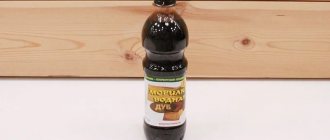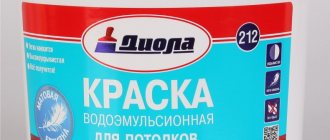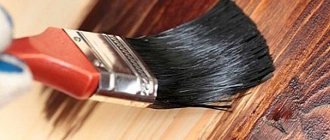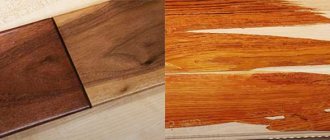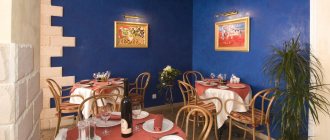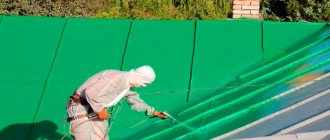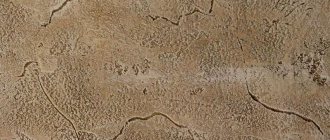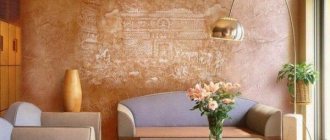What is wood glaze used for?
The glaze composition is capable of strengthening the surface without changing the original structure. This extends the service life of lumber structures. Improves appearance.
Antiseptic property protects against fungus, bugs and blue stains. Effective for soft woods that will not last long without coating.
The substance penetrates deep into the wood and strengthens the fibers. Due to this, they slowly age and crack.
The glaze composition protects building materials from ultraviolet radiation and other precipitation. There are filmless impregnations that preserve the vapor permeability of wood.
Azure protects timber, logs or boards from aggressive factors. The attractive appearance is maintained throughout the suggested service life.
What is a glazing composition and why is it needed?
Often, a glaze composition for decorative plaster acts as a finishing coating. The presented coating option serves as an additional protective layer that improves the quality of the decorative coating on the wall.
However, in addition to increasing strength and wear resistance, glazing materials give additional expressiveness to decorative plaster.
Finishing mixtures allow you to emphasize the color design of the walls, as well as highlight the relief of decorative plaster. There is a wide variety of glazing materials that have different properties and are used to achieve different purposes.
Varieties of azure
The product is oily, aqueous and soluble.
Let's look at the characteristics of each type:
- Water. The solvent is water. The product is quickly absorbed deep into the wood. After processing, a reliable coating layer is formed that does not emit harmful substances. The substance is suitable for bath treatment. When storing the product for a long time, sediment accumulates at the bottom. Therefore, shake the bottle a little before use.
- Oil. The composition is based on karst, linseed and other oils. These components are supplemented with rosin ether and vegetable alcohol. As a result, the formation of fungus is prevented. Instead of yellowing or blueing, the fiber structure is clearly emphasized. Oil glaze is divided into colored and colorless. The first option enhances the richness of the product.
- On solvents. The product reacts stably to temperature changes. Provides protection from sunlight, but caustic solvents during wood processing release toxic substances. It is not recommended to work with the composition indoors. Persistent pigments form the structure of the product.
Azure is divided into groups that differ in consistency and fluidity:
- Thin layer. Quickly soaks into wood fibers. However, it does not leave behind a reliable protective layer. Suitable for lining, picket fences and other materials of complex shape.
- Medium layer. The thick mixture quickly provides adequate protection, slowly penetrating inside and forming a thin layer. Most often used for frames, beams and other structures subject to slight deformation.
- Thick layer. When it dries, it forms a compacted protective layer. Suitable for use on all products that are not subject to deformation. Recommended for use on facades and other structures.
Features of applying oil impregnation
Working with such materials is not difficult, the main thing is to strictly follow the manufacturer’s instructions. After finishing the preparatory stage, dry the wood well. This is especially important if the material is still raw and new. Areas where resin is released are treated with white spirit using a piece of cloth.
The azure is prepared for work by mixing it well in a jar (the mass must be absolutely homogeneous in consistency). Then the impregnation is applied with a brush, roller, or a spray bottle is used on large areas. Apply 1 or 2-3 layers with a period of time that is enough for the previous layer to dry. To dilute oil glaze, you cannot use organic solvents; they are diluted only with oil or alcohol.
Interior decoration
You can apply glaze indoors to different types of wood. However, first you should clean the surface of the materials from the debris that has accumulated over the years.
- Azure is suitable for MDF, chipboard and other materials. The product is made on a water basis.
- Contains wax and resins, which enhances the appearance of the product.
- The main advantage is hiding defects and maintaining an attractive appearance.
- For greater decorativeness, pigments are added to the composition.
There is an environmentally friendly product, applicable when processing furniture and other items for general use.
What are impregnation and stain, what are oil and glaze?
Impregnation is any product that is used to impregnate wood to improve and preserve its properties. This can be called anything: from an antiseptic designed to protect the tree from biological damage, to a substance that gives color - after all, all these compounds impregnate the tree.
A stain is a substance that is used to treat wood to change its color or impart certain decorative, protective or priming characteristics. At the same time, substances that perform only one of the listed functions are often called stain.
That is, these concepts are somewhat blurred, the words impregnation and stain can be synonymous, but sometimes they are fundamentally different materials. The situation is simpler with the terms azure oil.
Azure is a decorative transparent product that colors and emphasizes the structure of wood and protects it from harmful influences. Azure coatings can be different: for example, in the line of the manufacturer Belinka there are 4 azures for different needs and areas of application: Lasur and Toplasur, Interier and Exterier.
Wood oil is simply a natural (read: safe) oil, sometimes with a mineral additive, that is used to protect the wood without altering its natural appearance. Oils are indispensable for hard-to-cut hardwoods such as oak, teak, larch.
Exterior finishing
The manufacturer uses alkyd resin and solvents as the basis for the product. The result is a durable layer of protection from ultraviolet radiation, precipitation and other negative factors.
The proven product provides protection for a period of 10 to 20 years. The manufacturer provides consumers with azure of different colors, which is suitable for painting fences, facades and other structures or structures.
Useful properties and disadvantages
Finishing walls has a number of advantages compared to conventional coating without a protective layer. Among the main advantages it is worth noting:
- The composition gives the surface additional shine and shine.
- A wall with a glaze coating has increased strength and wear resistance.
- Varnish, paint and wax can solve the problem of fading of the plaster mixture.
- Additional coating allows you to highlight the relief of decorative plaster.
- Application of a protective film allows for wet cleaning of walls.
However, treatment with a glazing composition has several disadvantages, among which the following were identified:
- When using varnish, paint or wax, replacing decorative plaster will be much more difficult, since in this case you will have to completely remove sections of the coating.
- Carrying out work with a glazing composition requires additional financial costs.
What to choose
Glaze or oil can be used for protective or decorative purposes. Both remedies are effective, but have different effects on the final result. Azure attracts with its glossy layer. The oil has a matte finish. Therefore, the choice is determined by the creative needs of the consumer.
- The matte finish is due to the use of oil. Gloss is the result of adding solvents to the composition.
- Two types of products provide adequate protection and impress with decorative features.
- In this way, it is possible to revive the old structure and put it in complete order.
Glossy glaze forms a durable protective layer, satisfying the consumer with decorative prospects. The product is suitable for products with an uneven surface: it hides defects and camouflages thanks to its radiance and smoothness.
Solvent-based glaze application
The procedure for preparing the surface will be similar to that described above. Be sure to sand the wood - this will help not only level the material, but also open its pores. You cannot apply glaze to products that have been previously painted or impregnated with other glazing compounds - first the coating is removed mechanically or chemically.
Solvent-based glazes almost never require dilution and usually have an optimal consistency. Excessive addition of thinner can ruin the composition! Work is carried out at temperatures above +5 degrees in the absence of bright sun, so it is best to paint wood in the early hours in summer or autumn. The glaze is applied with a roller or brush, unevenly painted areas are wiped with white spirit, and then treated again.
Deciding on the color
There is a product on the market with the ability to enhance an existing color or add a new one. Even ordinary grade wood, after being treated with glaze, acquires a noble appearance.
The resulting shade depends on the tone of the product. Density and service life also affect. Test the product and choose the appropriate option.
- Light colors are the most popular. Transparent glaze is also used, but the result is not always impressive.
- It is recommended to purchase a product with light pigments or whitening impregnation.
- We lighten the wood and get a spectacular material.
- Don’t forget to apply a protective compound against ultraviolet radiation and the structure will remain intact for another 10-20 years.
Take a closer look at the product from the Belinka brand, which is sold in different shades of living wood: walnut, oak, pine and others. Beige or gray azure will renew old wood. Change the tone by adding different pigments and get a practical coloring tool.
In general, this tool is suitable for different tasks. It will keep the already old material intact. It will improve the appearance, allowing you to seamlessly integrate into the overall home interior.
Universal protective glaze for wood for outdoor use
In general, wood glazes are transparent or translucent, silky-matte or glossy decorative coatings. Azure can be colorless (less commonly) or colored (tinted), but in both cases it does not completely cover the wood pattern, but gives a given shade and, if possible, preserves naturalness.
Usually this is a finishing decorative coating that completes finishing work on a wooden facade or building. And before applying the glaze, it is necessary to impregnate the surface with an antiseptic and primer. The antiseptic prevents biological damage (blue stains, mold, fungi), and the primer increases adhesion and ensures uniformity of the finishing layer.
That is, classically, facade processing is carried out in several stages, using specialized products.
But there is a way to reduce the number of operations without losing efficiency - use a universal (impregnating) protective glaze on wood for outdoor use.
Adler specialist
Manufacturers have been receiving requests for many years: is it possible to combine an antiseptic impregnation with protective properties, a primer (adhesive preparation) and a coating in one composition? And for this composition to “work”! On the other hand, it is known that a high-quality coating almost always looks like a layer of varnish - the film is still visible. Shine, even silky or semi-matte, is still the shine of plastic, but the idea of a wooden house is naturalness, naturalness, a natural look and feel. Tinting wood and protecting it from fading without a visible film is a real fashion trend and a real concern for the ecology of the home. And they managed to satisfy all requests. Universal protective glaze for wood is a product that contains ultraviolet filters (that is, it prevents wood and paint from “fading” over time), imparts water-repellent properties and does not remain a film on the wood.
Universal protective glaze is an impregnation, primer and topcoat in one product.
It contains a solvent without a characteristic chemical odor, alkyd resins, and active biocidal substances. After application, the surface of the wood becomes more expressive, while maintaining its natural matte finish and the ability to “breathe”. But it becomes unsuitable for pests and impermeable to atmospheric factors.
Adler specialist
Let's see what happened:
- a stable product with a dense structure and a high dry residue - the solvent evaporates, and what remains on the surface is the dry residue, the higher this percentage, the more effective the product;
- serious composition of biocides - modern additives, including protection against insects (unique) and all fungi (coloring and destructive);
- uniform distribution over the surface (spreading) and absorption – stunning visual characteristics of painted wood;
- excellent light fastness - thanks to new generation pigments, UV-resistant polymer composition and filters.
How to prepare the surface
Without a prepared surface, the quality and design of the coating is a big question mark. Please consider the following points before processing.
- We wash new wood under running water, and clean old wood with a wire brush.
- Products with patterns are processed by a specialized machine with separate attachments.
- Damaged products must first be puttied with mastic.
- Old glaze is treated with a special solution and removed from the surface.
- Stains on the surface are removed with methyl alcohol.
Preparing the surface for impregnation
For a beautiful and high-quality application of impregnation, the base must be well prepared. Only in this case will the applied coating really last for many years. The method of processing wood depends on its age, condition, strength and type of structure:
- strong wood with old paintwork can be processed using a sandblasting machine or cleaned with a scraper or wire brush;
- It is recommended to wash new wood or contaminated material with water under pressure;
- carved items, patterned shutters, railings, fences should be cleaned with a grinding machine with a special attachment;
- materials with chips and cracks must be puttied with suitable mastic;
- wood with old glaze must be treated with a special etching compound to remove the coating;
- stains from pens, felt-tip pens, and other difficult-to-remove marks can be removed with aerosol chlorine-free solvents, ammonia, methyl alcohol, or by sanding.
After any type of pre-treatment, the base must be well polished with a machine or sandpaper to get rid of burrs and irregularities. Afterwards, the wood is wiped with alcohol, turpentine, and allowed to dry completely.
